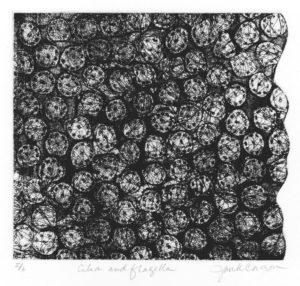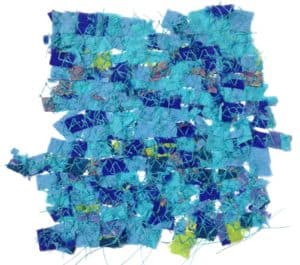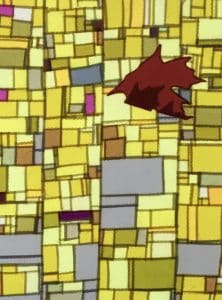“Emptiness is one of those Buddhist terms that is so hard to define and translate into English. Emptiness really refers to reality as it is, that everything in the world is empty of a fixed, permanent, abiding self. In other words, everything is impermanent. Everything changes. And at the same time, everything is also completely interconnected and coexists with everything else and cannot exist without everything else. And so it’s just simply describing the nature of things to materialize, to constellate, to come into being, to come into form, and then to fall apart again.”
– Ruth Ozeki
I hold Jan R. Carson’s artistic body of work in high esteem. Looking at her artworks and listening to what she has to say about it leads me to the following understanding of it. The works exist as a manifestation of the interplay between the small and the large. The careful small stitching of threads attaches a little area of fabric that forms a larger pattern of colors which make up a coherent form–a whole which is an exemplar of the composition itself. The idea of the whole as an exemplar of itself means the artwork is a depiction of the growth of the composition itself, something like the ideas for understanding the “action painting” of Jackson Pollock for example. There is a difference from action painting, however. In action painting, the supposed source of the composition arises from the interior emotions, and/or sensibilities of the artist. On the other hand, Carson’s work we might say “grows itself.” Although like the abstract expressionists, she often remarks that she works intuitively, without a plan, just adding what seems to want to happen next in the creation of the artwork, she is not suggesting that she has a “big” feeling or intuition that she is personally expressing. One might say that Jan Carson’s art “grows” more than it gushes forth. The finished product calls attention to this process.
 From the beginning, her subject matter has been the organism. Her early forays in art were connected with the human body—in fact the small elements that compose the human body. I own an early print of hers called Cilia and Flagella, hairlike forms or processes which might aid in flowing fluids in bodies, or in the case of one-celled organisms, propelling the organism through a fluid. I have another piece (a sculpture?) which represents a red blood cell, filched from a tub of these she once exhibited as an undergraduate.
From the beginning, her subject matter has been the organism. Her early forays in art were connected with the human body—in fact the small elements that compose the human body. I own an early print of hers called Cilia and Flagella, hairlike forms or processes which might aid in flowing fluids in bodies, or in the case of one-celled organisms, propelling the organism through a fluid. I have another piece (a sculpture?) which represents a red blood cell, filched from a tub of these she once exhibited as an undergraduate.
After her MFA in fiber arts from Colorado State University, she made her way as an artist by making mobiles of leaves made of silk and had enough success at this that she still turns out a supply that sells in upscale gift shops. Additionally, she made larger mobile installations for placement in buildings like hospitals, again of leaves. Then she hit on producing stitched fabric wall art. This is where she invented her painstaking process of stitching small pieces of fabric in patterns and designs mostly interpreting the seasons of Nature. In 2018 she photographed these large creations (most of them around four and a half feet tall and three and a half feet wide) and put them into a self-produced calendar of The Seasons Series. In a note on the inside of the cover of the calendar she explained something of her artistic process:
My art is created by slicing and seaming silk fabric in repetitive turns, inviting
arbitrary placement of individual colors and shapes. Sewing as a creative process
allows me to easily divide, mend, and reconfigure as I explore the effects of my
actions. Even as the instigator of its creation, I am above all fascinated by observing
each artwork’s journey to completion.
This is a peculiar way of talking about the creative process outside of novelists who often claim that the characters they have invented tend to “take over” the direction of the narrative and as it were write their own story. But even there, the novelist begins with a relative conception of a whole person. In Carson’s case she claims to operate at a more minute level in which every, so to speak, “atomic” element is itself alive with its own bit of “creativity” in its unfolding connection to the next bit. She “watches” the artwork’s journey to completion.
 The fabric wall art will strike most observers at first as abstract decoration, the sort of pieces that one might find in doctors’ offices, or other professionals who want their clients to feel comfortable waiting for some time—splashes of color or design that make it easy to feel comfortable in a well ordered and tasteful place. And there is no denying that they have that soothing, easy on the eye effect. Yet their size would give us pause in thinking they were just an “accent” in an effort to decorate for an appealing room. If you paused to look closer at the works, you would inevitably be drawn to the stitching by which a small piece of fabric is connected to other pieces of fabric and eventually holds the entire piece together. Indeed, I have two small “swatches” of her stitching work, roughly 4 x 4 inches wide framed in a 10 x 12-inch frame hanging in my hallway at home. Often, visitors to our house stop in front of these barely hanging together pieces of fabric and inspect them closely. These seem for most people to be special, intrinsically delightful, moments of creative energy. This is a compelling clue that testifies to a greater complexity of the wall art. It calls attention to the aspect present in all of the wall art, but sublimated, partly by the fact that the fabric of the wall art covers the entire “canvas” so to speak and is not highlighted by being framed for its own sake.
The fabric wall art will strike most observers at first as abstract decoration, the sort of pieces that one might find in doctors’ offices, or other professionals who want their clients to feel comfortable waiting for some time—splashes of color or design that make it easy to feel comfortable in a well ordered and tasteful place. And there is no denying that they have that soothing, easy on the eye effect. Yet their size would give us pause in thinking they were just an “accent” in an effort to decorate for an appealing room. If you paused to look closer at the works, you would inevitably be drawn to the stitching by which a small piece of fabric is connected to other pieces of fabric and eventually holds the entire piece together. Indeed, I have two small “swatches” of her stitching work, roughly 4 x 4 inches wide framed in a 10 x 12-inch frame hanging in my hallway at home. Often, visitors to our house stop in front of these barely hanging together pieces of fabric and inspect them closely. These seem for most people to be special, intrinsically delightful, moments of creative energy. This is a compelling clue that testifies to a greater complexity of the wall art. It calls attention to the aspect present in all of the wall art, but sublimated, partly by the fact that the fabric of the wall art covers the entire “canvas” so to speak and is not highlighted by being framed for its own sake.
All of her artworks are titled. There is no possibility of seeing something of hers that is titled Composition in Blue, Yellow, and Black or Number 62. There is no doubt that her works are about something. She is a representationalist all the way down, even if she might be representing something that is phenomenological, though not material—like a feeling or a season. Because of a certain “scientific” cast to her mind, she is forever fascinated by how the smaller parts of things connect with one another to enable the emergence of a larger thing.
As a way of complicating this emergent method, Carson has recently added the element of light as part of her compositional method. We use light of course to see everything, but we think of light as something additional by which to see the things of the world. As one of her first forays into working light into her compositions, she studied the science of how bees see the wavelengths they do and produced a work called See As Bees See. Since bees see heavily in the blue wavelengths, the resulting composition had a deep blue and violet cast to it and was illuminated from behind by a series of lights, carefully placed on the inside of the frame, but behind the fabric. The result is a marvelous transformation of the fabric work as glowing with self-possessed light, an exciting reaching out of the artwork toward its observer that fills one’s senses. (See As Bees See won the 218 Arrow Five Years Out Art competition in Denver and now resides in the collection of Arrow Electronics.) She followed this with an even more extravagant five-paneled work entitled The Screaming Dreams of Flowers. This piece, which is now owned by the city of Loveland, Colorado, had an added element that has not been far from any of Carson’s more recent creations—the theme of disintegration. The environment is under attack and that means difficulty for any of the beings who have been built up by the creativity of the small things that compose it and are now unable to find a sure path to their flowering forth. But the light was still illuminating the works and that heartbeat of color (which is light in some wavelength or another) remains.
She is now creating lightboxes where things seem to be less ordered, and where gradually more representational objects are displayed within the composition, mostly collapsing, or torn apart, or in some way alienated from themselves. This began with her Observer Series, works in which a human shadow image appears, in earlier moments as simply a ghostly inhabitant of the piece, but later broken up into segments: an arm, a head, a leg. These strike me as adding something that was missing from the earlier work which did not have represented images (of animals or persons or objects in the ordinary sense). The earlier work was an image in some way of the world “out there,” not so much what we subjectively see, but what is there, in-itself. But beginning with the Observer Series, the subjective for-itself invades. The figure does not have a robust personality with specific and differentiated reactions to its own environment. It simply adds the dimension of “observability” to the mix of the work. Now the creativity of the small which builds up the large is also being noticed. So the vulnerability of the small creative parts now can be evidenced because there is an awareness of what is happening when the process is going well as opposed to when it begins to fail to work well. There is a certain dumb sadness and alienation that controls the overall effect. Once the shadow figure appears, the possibilities of following the marvelous creativity of the small in constructing the large can no longer be the dominant message. The light still gives the impression of health and vibrancy, but it is immediately countered by the overpowering darkness of the shadow figure. What had begun in the wall art of the celebration of the world now takes on the shadow of tragedy.
 In the history of visual arts in the West, the subject matter was, until perhaps the mid-nineteenth century, about the represented images in the work. Religious, Mythic, Civic and Political subject matter dominated Painting. Even when pastoral landscaping and still life became important, the attitude of the viewer was always directed toward how well in accuracy and beauty the subject matter was rendered. Only in the twentieth century did the visual arts catch up with the Romantic revolution where notions like “genius” came to be the center of attention. Then it was possible to care about the inner life of the artist as something first and foremost. So in the visual arts, it has only been about a hundred years since the displacement of the Aristotelian doctrine of art as imitation.
In the history of visual arts in the West, the subject matter was, until perhaps the mid-nineteenth century, about the represented images in the work. Religious, Mythic, Civic and Political subject matter dominated Painting. Even when pastoral landscaping and still life became important, the attitude of the viewer was always directed toward how well in accuracy and beauty the subject matter was rendered. Only in the twentieth century did the visual arts catch up with the Romantic revolution where notions like “genius” came to be the center of attention. Then it was possible to care about the inner life of the artist as something first and foremost. So in the visual arts, it has only been about a hundred years since the displacement of the Aristotelian doctrine of art as imitation.
Carson’s art, however, is a last extreme of Aristotle’s teaching; extreme enough that Aristotle would be unlikely to see it that way. For Aristotle, imitation would be understood as the imitation of things in the world even if that included non-material objects, like the actions of people, with all their “invisible parts” like motivations, or moral weight. But Aristotle could not have imagined that anyone could imitate the world process itself, which after all, is not a thing in the world. But a basic imitation is at work in all of Carson’s fabric art. It is the imitation of the world process itself. This controls every piece. Her gradual introduction of things in the world (butterflies, birds, people) as her awareness and her sadness of environmental decay increased, could not destroy her ground insight that the world process remains. What is always manifest is that the small connects the larger. The atomically small (perhaps the quark or the string in physics) may not be able to be made manifest at all. But the working of the world process can be represented—the stitching together of larger pieces. At a distance from her artworks, it is not possible for our human eyes to see the stitching together of the pieces of the world contained there, but you can be sure that the process is at work for anything at all to appear, in particular, a pattern. Often it is instructive to look very closely at a great painting—say one by Van Gogh or Monet—to see how the small brushstrokes were carefully applied so as to give the painting its desired effect. But Carson’s small stitches do not give you this same satisfaction. Look up close and wherever you look, it is just going to be stitches. They have an essential function, but not the sort that would make you see how they contributed to some specific effect that the whole produces. But all of her fabric art, whatever the effect and whatever “understanding” you have of them, owes its very existence to the stitch. So each piece, though specific, is itself an imitation of the world process. Quite an achievement.
* * * * *
Notes from Jan:
Dr. Ed Lawry made his career as Professor of Philosophy at Oklahoma State University. He is now retired and living in Oregon. I’ve known him since I was a freshman in college, which was before I made any art of consequence, and he has been an ardent source of encouragement. His belief in my vision and ability has had an immeasurable effect on my perseverance through the struggles I’ve encountered in my pursuit of authentic artistic expression.
Ruth Ozeki is a novelist and Zen Buddhist priest. The quotation above was taken from an interview with Ezra Klein on “The Ezra Klein Show,” a production of New York Times Opinion. A transcript of the interview can be found here.